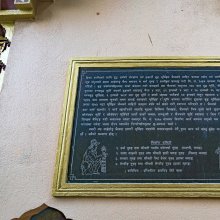Pishanga, Piśaṅga, Pisamga, Pishamga: 14 definitions
Introduction:
Pishanga means something in Hinduism, Sanskrit, Jainism, Prakrit. If you want to know the exact meaning, history, etymology or English translation of this term then check out the descriptions on this page. Add your comment or reference to a book if you want to contribute to this summary article.
The Sanskrit term Piśaṅga can be transliterated into English as Pisanga or Pishanga, using the IAST transliteration scheme (?).
Images (photo gallery)
In Hinduism
Purana and Itihasa (epic history)
Source: archive.org: Puranic EncyclopediaPiśaṅga (पिशङ्ग).—A serpent born of the family of Dhṛtarāṣṭra. This serpent was burnt to death at the Sarpasatra of JanameJaya. (Śloka 17, Chapter 57, Ādi Parva).
Source: Cologne Digital Sanskrit Dictionaries: The Purana Index1a) Piśaṅga (पिशङ्ग).—A Yakṣa; a son of Devajani.*
- * Brahmāṇḍa-purāṇa III. 7. 128.
1b) A mountain to the south-west of the Kailāsa Mountain.*
- * Vāyu-purāṇa 47. 9.
Piśaṅga (पिशङ्ग) is a name mentioned in the Mahābhārata (cf. I.52.15, I.57) and represents one of the many proper names used for people and places. Note: The Mahābhārata (mentioning Piśaṅga) is a Sanskrit epic poem consisting of 100,000 ślokas (metrical verses) and is over 2000 years old.

The Purana (पुराण, purāṇas) refers to Sanskrit literature preserving ancient India’s vast cultural history, including historical legends, religious ceremonies, various arts and sciences. The eighteen mahapuranas total over 400,000 shlokas (metrical couplets) and date to at least several centuries BCE.
Languages of India and abroad
Sanskrit dictionary
Source: DDSA: The practical Sanskrit-English dictionaryPiśaṅga (पिशङ्ग).—a/ [piṃś-aṅgac kicca] Reddish-brown, reddish, of a tawny colour; मध्येसमुद्रं ककुभः पिशङ्गीः (madhyesamudraṃ kakubhaḥ piśaṅgīḥ) Śiśupālavadha 3.33;1.6; Kirātārjunīya 4.36.
-ṅgaḥ The tawny colour.
Source: Cologne Digital Sanskrit Dictionaries: Shabda-Sagara Sanskrit-English DictionaryPiśaṅga (पिशङ्ग).—mfn.
(-ṅgaḥ-ṅgā-ṅgī-ṅgaṃ) Of a tawny or brown colour. m.
(-ṅgaḥ) Tawny, (the colour.) E. piś to be a component part, aṅgac aff.
--- OR ---
Pisaṅga (पिसङ्ग).—m.
(-ṅgaḥ) Tawny (the colour): see piśaṅga. E. pisa, aṅgac aff.
Source: Cologne Digital Sanskrit Dictionaries: Benfey Sanskrit-English DictionaryPiśaṅga (पिशङ्ग).— (vb. piś), adj., f. gī and gā, Of a tawny, or brown, or reddish colour, [Kathāsaritsāgara, (ed. Brockhaus.)] 1, 18.
Source: Cologne Digital Sanskrit Dictionaries: Cappeller Sanskrit-English DictionaryPiśaṅga (पिशङ्ग).—[feminine] ī reddish brown.
Source: Cologne Digital Sanskrit Dictionaries: Monier-Williams Sanskrit-English Dictionary1) Piśaṅga (पिशङ्ग):—[from piś] mf(ī)n. reddish, r°-brown or -yellow, tawny, [Ṛg-veda] etc. etc.
2) [v.s. ...] m. a r° or tawny colour, [Horace H. Wilson]
3) [v.s. ...] Name of a serpent-demon, [Tāṇḍya-brāhmaṇa; Mahābhārata]
Source: Cologne Digital Sanskrit Dictionaries: Yates Sanskrit-English DictionaryPiśaṅga (पिशङ्ग):—(ṅgaḥ) 1. m. Tawny colour.
Source: DDSA: Paia-sadda-mahannavo; a comprehensive Prakrit Hindi dictionary (S)Piśaṅga (पिशङ्ग) in the Sanskrit language is related to the Prakrit word: Pisaṃga.
[Sanskrit to German]
Sanskrit, also spelled संस्कृतम् (saṃskṛtam), is an ancient language of India commonly seen as the grandmother of the Indo-European language family (even English!). Closely allied with Prakrit and Pali, Sanskrit is more exhaustive in both grammar and terms and has the most extensive collection of literature in the world, greatly surpassing its sister-languages Greek and Latin.
Prakrit-English dictionary
Source: DDSA: Paia-sadda-mahannavo; a comprehensive Prakrit Hindi dictionaryPisaṃga (पिसंग) in the Prakrit language is related to the Sanskrit word: Piśaṅga.
Prakrit is an ancient language closely associated with both Pali and Sanskrit. Jain literature is often composed in this language or sub-dialects, such as the Agamas and their commentaries which are written in Ardhamagadhi and Maharashtri Prakrit. The earliest extant texts can be dated to as early as the 4th century BCE although core portions might be older.
Kannada-English dictionary
Source: Alar: Kannada-English corpusPiśaṃga (ಪಿಶಂಗ):—
1) [adjective] of reddish brown colour.
2) [adjective] of light red colour.
--- OR ---
Piśaṃga (ಪಿಶಂಗ):—
1) [noun] brown colour.
2) [noun] reddish yellow or golden yellow colour.
Kannada is a Dravidian language (as opposed to the Indo-European language family) mainly spoken in the southwestern region of India.
See also (Relevant definitions)
Starts with: Pishamgashma, Pishamgate, Pishangabha, Pishangabhrishti, Pishangajata, Pishangaka, Pishangamanu, Pishangarati, Pishangarupa, Pishangasamdrish, Pishangashva, Pishangata, Pishangatva, Pishangavarna, Pishangaya.
Ends with: Apishanga, Arunapishanga, Shalalipishanga.
Full-text (+2): Pishangasamdrish, Pishamgate, Pishangabhrishti, Pishangarupa, Pishangata, Pishangatva, Pishangarati, Pishangajata, Pishanka, Apishanga, Pishangaka, Pisita, Arunapishanga, Pishangashva, Pishangin, Picankam, Pishangi, Aikara, Ekara, Shalalipishanga.
Relevant text
Search found 11 books and stories containing Pishanga, Pisamga, Pisaṃga, Piśaṃga, Piśaṅga, Pisanga, Pisaṅga, Pishamga; (plurals include: Pishangas, Pisamgas, Pisaṃgas, Piśaṃgas, Piśaṅgas, Pisangas, Pisaṅgas, Pishamgas). You can also click to the full overview containing English textual excerpts. Below are direct links for the most relevant articles:
Rig Veda (translation and commentary) (by H. H. Wilson)
List of Mahabharata people and places (by Laxman Burdak)
Bhakti-rasamrta-sindhu (by Śrīla Rūpa Gosvāmī)
Verse 3.2.9 < [Part 2 - Affection and Service (dāsya-rasa)]
Verse 2.1.353 < [Part 1 - Ecstatic Excitants (vibhāva)]
The Matsya Purana (critical study) (by Kushal Kalita)
Part 2.2 - Different names of Śiva < [Chapter 4 - Religious aspects of the Matsyapurāṇa]
Mahabharata (English) (by Kisari Mohan Ganguli)
Section LVII < [Astika Parva]
Rivers in Ancient India (study) (by Archana Sarma)
15. The river Lauhitya or Brahmaputra and its present status < [Chapter 6 - Changing trends of the Rivers from Vedic to Purāṇic Age]
10. Various other rivers in the Purāṇas < [Chapter 5 - Rivers in the Purāṇic Literature]
